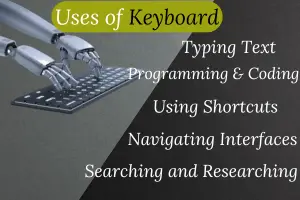Advantages and Disadvantages of Computer Keyboards
Published: 18 Jan 2025
Keyboards have been the backbone of typing since the invention of computers. They have transformed how we work and communicate, from standard QWERTY layouts to ergonomic designs. But did you know that every keyboard type has its benefits and drawbacks? In this guide, we’ll explore the five advantages and disadvantages of keyboards to help you make the best decision.
Advantages of a Computer Keyboard
Keyboards play an important role in how we engage with computers. Their functionality extends beyond basic typing. Here are the detailed benefits:

1. Speed and Efficiency
Keyboards allow users to type more quickly compared to writing by hand. This makes completing tasks quicker for students, professionals, and writers. For example, a typewriter can average 60-80 words per minute, which is far faster than handwriting.
2. Wide Range of Types
Users can select between mechanical and membrane keyboards depending on their needs. Mechanical keyboards deliver tactile feedback for games, although membrane keyboards are smoother and typically favored in offices.
3. Enhanced Accessibility
Modern keyboards offer features like backlighting, adjustable heights, and large key labels. These features assist users with visual or physical challenges. For example, a backlit keyboard is perfect for working in a low-light room.
4. Customization Options
Keyboards now feature customizable keys. Gamers can assign specific actions to keys, while professionals can use shortcuts for activities such as program launch or repetitive work completion.
5. Durability
Mechanical keyboards are well-known for their durability. Many versions boast a tens of millions keystroke rating, guaranteeing long-term durability with minimal wear and tear.
To fully enjoy the advantages of a keyboard, it must work smoothly. Use our keyboard test tool online to check for any faulty keys and ensure the best performance.
Also Read this 👇👇
Advantages and Disadvantages of Modern Speakers
Pros and Cons of Thin and Lightweight Laptops
Advantages and Disadvantages of Webcams
Laptop vs Desktop: Pros and Cons
Advantages and Disadvantages of Computer Mouse
Disadvantages of a Keyboard
While keyboards are essential, they have limits. It is necessary to understand these disadvantages in order to make informed decisions:

1. Health Concerns
Prolonged keyboard use can cause wrist pain, carpal tunnel syndrome, and other repetitive strain injuries. Poor posture while typing can worsen these issues over time.
2. Space Requirements
Keyboards, particularly full-size ones, require proper desk space. This can be inconvenient for users with small workstations.
3. Learning Curve for New Users
Not everyone finds keyboards easy to use, particularly small children and older persons new to computers. Learning the key layout and shortcuts takes time and practice.
4. Dependency on Hardware
If a keyboard malfunctions or stops working, it can completely halt tasks. Unlike touchscreen devices, which have integrated keyboards, external keyboards rely on their physical presence.
5. Noise Levels
Some types, such as mechanical keyboards, can be noisy. This might cause disturbance in shared spaces like offices or libraries.
What Should You Look for When Choosing a Keyboard?
If you’re thinking about getting a new keyboard for schoolwork, here are a few things to consider:
- Comfort: Choose a keyboard that feels comfortable for your hands.
- Size: Make sure it fits on your desk with enough space for your books.
- Durability: Look for a keyboard that will last through your typing sessions.
- Quietness: If you study in a quiet place, a quiet keyboard might be best.
What are the advantages of using a keyboard as an input device?
Keyboards are fast and efficient, making them ideal for typing long texts. They allow for precise control over your input, making them great for tasks like writing essays or coding. Keyboards also support shortcuts, which can save time when working on a computer.
What is the full form of keyboard?
The word “keyboard” doesn’t have a full form. It is just the name of the device used to enter text and commands into a computer. It comes from the archaic terms “key” and “board,” which refer to keys set on a board.
How do keyboards work?
When you press a key on a keyboard, electrical signals are sent to your computer. Each key represents a separate signal, which the computer translates as a letter, number, or command. The keyboard interfaces with the computer using either a wired or wireless connection.
What is F1, F2, F3, F4, F5, F6, F7, F8, F9, F10, F11, f12?
The F1 to F12 keys are known as function keys, and their purpose varies depending on the program being used. For example, F1 frequently opens help, whereas F5 is routinely used to refresh a website. Function keys help speed up tasks by performing particular commands without using the mouse.
Conclusion
Now that you understand the benefits and drawbacks of keyboards, it’s time to take action. Consider your specific requirements—whether for work, gaming, or studying—and select a keyboard that matches your goals. Don’t forget to prioritize comfort and functionality for the best experience!

- Be Respectful
- Stay Relevant
- Stay Positive
- True Feedback
- Encourage Discussion
- Avoid Spamming
- No Fake News
- Don't Copy-Paste
- No Personal Attacks



- Be Respectful
- Stay Relevant
- Stay Positive
- True Feedback
- Encourage Discussion
- Avoid Spamming
- No Fake News
- Don't Copy-Paste
- No Personal Attacks





